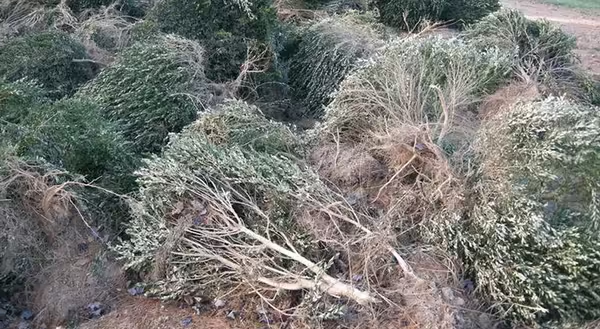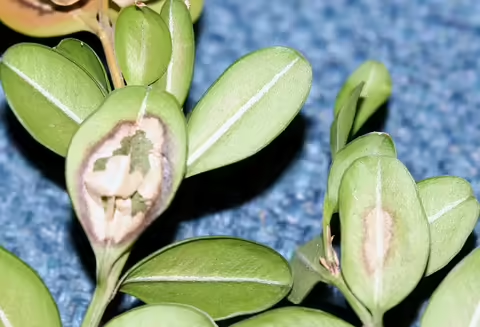
With the recent detections of boxwood blight, which is a regulated plant disease, in Illinois, the importance of scouting landscapes and new plants for the disease is greater than ever. Boxwood blight can be a challenging disease to identify outside a plant diagnostic laboratory. Many of the symptoms associated with the disease are similar to other common boxwood disorders.
One major difference between boxwood blight and its look-alikes is the potential for defoliation. Boxwood blight causes extensive defoliation, while look-alike disorders tend to have leaves turn tan to brown, but remain attached to the plant. A microscope is needed to confirm the disease diagnosis.
Common boxwood blight look-alikes: winter Injury, Macrophoma leaf spot, Volutella blight, Phytophthora root rot, Fusarium canker, boxwood leafminer, and potentially boxwood psyllid.
Fortunately, these look-alikes cause a relatively minor injury that can be pruned out during a dry period of spring weather.
If you suspect boxwood blight, we recommend you contact the University of Illinois Plant Clinic for information on how to submit a sample. Never take a suspected boxwood blight sample to a garden center, nursery, or other areas that may grow or distribute boxwood. While these businesses may offer plant advice as a service to their customers, they are extremely cautious and go to great lengths not to introduce or spread this disease.
More about boxwood blight best management practices is available in this Boxwood Health Production and Landscape Management guide.
Winter Injury (Abiotic)
Winter injury occurs as cold, dry winter winds and/or direct sunlight causes moisture loss from the evergreen leaves. Frozen soil prevents the plant from taking up water resulting in “freeze-dried” burn symptoms. Depending on a plant’s hardiness, location, and weather conditions, winter injury can damage the entire plant or just the branch or leaf tips causing leaves to become pale yellow/reddish-bronze. The pattern of injury can also help diagnose winter injury. Injury is most likely to occur southwest and windward facing sides of the plant. A “snow line,” or distinct line that separates the healthy green bottom from the damaged brown top can also be an indication of winter injury. Snow insulates and protects foliage from desiccating winds and extreme cold temperatures.
Macrophoma Leaf Spot (Macrophoma candollei)
Macrophoma is a weak pathogen that causes leaf spots and straw-colored leaves. The disease can easily be identified by the numerous black, raised fruiting bodies found on dead or dying leaves
Volutella Blight (Volutella buxii (asexual stage of Pseudonectria rouselliana))
This fungal pathogen is often associated with stem and leaf tissues damaged from winter injury. Infected leaves turn tan, straw-yellow or bronze color in the spring. Volutella progresses down the stem, whereas winter injury happens seemingly at once. Under moist, humid conditions, the foliage may develop distinct masses of pink to salmon-colored spores
Phytophthora Root Rot (Phytophthora spp.)
Heavy, wet soils favor Phytophthora root rot. There are many species of Phytophthora, some of which have a broad host range. In boxwood, Phytophthora can cause individual branch wilting and dieback (Photo 1) leaving isolated areas of pale green, then brown, shriveled leaves attached to the stems. Roots are often dark brown or black, sparse, and brittle, and the cambium (inner tissue under the bark) at the base of the main stems may also become discolored dark brown or black. Management consists of removing infected plants; available chemical control is best used as a preventative, but does very little once an infection has been established. Boxwood beds should be well-drained and overwatering avoided. If a plant is removed due to Phytophthoraroot rot, avoid planting other susceptible plants in that area. Symptomatic boxwood plants can be tested for Phytophthora, however, root or base tissue is needed. If multiple plants are affected and you are concerned about replanting, you may want to consider digging up an entire plant to submit to the Plant Clinic.
Fusarium Canker (Fusarium spp.)
Fusarium cankers on boxwood do not appear to be common in the landscape. At the Plant Clinic, we have only seen them on samples submitted from nurseries or greenhouse producers. We suspect this is due to cultural conditions in the nurseries (plants situated close together, high humidity from overhead watering or plentiful irrigation) which favor the development of this disease. In our experience, fusarium cankers are more commonly found at the tips of branches compared to boxwood blight, which may be found near the base or the middle of branches. Fusarium cankers appear as dark brown or black streaks along boxwood branches that quickly coalesce into contiguous patches of discolored tissue. These cankers appear very similar to those caused by boxwood blight, and both may cause defoliation. Because of this, individual spores of the pathogen must be observed under the microscope to differentiate between the two. This is yet another reason to have the disease confirmed by a diagnostic laboratory.
Boxwood Leafminer (Monarthropalpus buxi)
Boxwood leafminer causes off‐green pouches on leaves that turn brownish as the larvae. Because partially‐grown larvae overwinter, heavily affected leaves develop light brown mottling in the spring when other foliage is green. This mottling occurs on both the under‐ and uppersides of the leaves. Photo 2.
Boxwood Psyllid (Pyslla buxi)
Boxwood psyllids are small (1/16-inch), grayish green insects that are normally covered with a white, waxy, filamentous secretion that partially covers the body, providing protection from parasitoids and sprays of pest-control materials. Eggs overwinter and hatch into yellowish nymphs that begin feeding as soon as buds begin to open in early spring. The first-instar nymphs feed by sucking plant fluids from terminal leaves as they unfold and expand in spring. Their feeding causes leaves to yellow, curl, and form a cup, which conceals and protects the nymphs. There is one generation per year.
Learn more about Illinois invasive species.
Main photo: Mary Ann Hansen, Virginia Polytechnic Institute and State University, Bugwood.org
ABOUT THE AUTHORS
Travis Cleveland is a Plant Pathology specialist for University of Illinois Extension. He provides subject matter expertise and training in pesticide safety with an emphasis on plant pathology and diagnostic support for the Plant Clinic. He coordinates the Home, Yard and Garden Pest Newsletter.
Diane Plewa is a Plant Diagnostic Outreach Specialist with the University of Illinois Plant Clinic.

